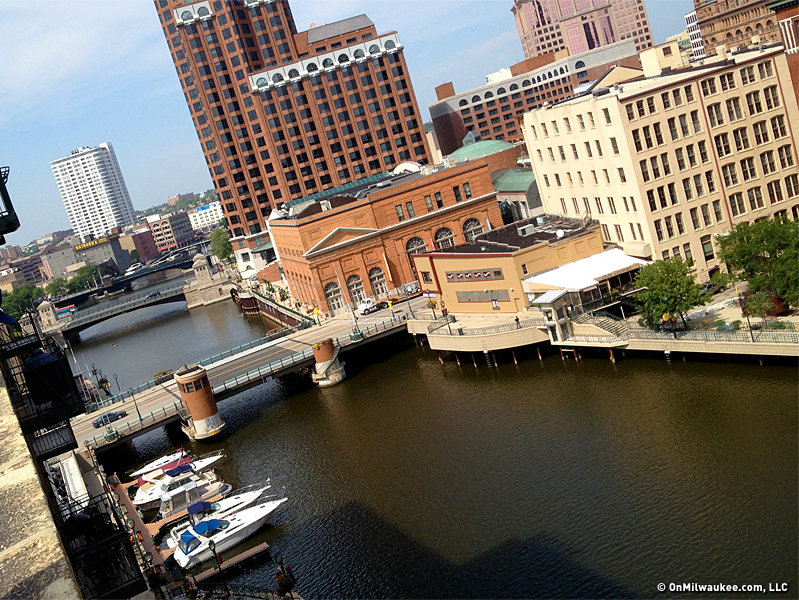If you want to know why John Gurda compares the Milwaukee River to a recovering alcoholic, be sure to check out his latest lecture tour, "Built on Water: Milwaukee’s Vital Resource."
So why the comparison?
"It was a river that had just huge problems and it’s on the uptick now, but the dangers of a relapse are always present," Gurda told OnMilwaukee.com.
The tour begins tonight at the Urban Ecology Center in Riverside Park and takes a look at the history of Lake Michigan and its adjacent waterways, focusing on its role in immigration and industry as well as the ways in which it has been adversely affected by human activity.
Gurda will give these lectures at various locations throughout the watershed through Thursday, Nov. 7. For a complete schedule, visit uwex.edu. The presentation will be slightly tweaked to be made more relevant to the area in which it is being given.
The lecture is presented by the University of Wisconsin-Extension (UWEX) and the Great Lakes Restoration Initiative, and is made possible by a grant from the Department of Natural Resources.
The Milwaukee Estuary was designated by the International Joint Commission as an Area of Concern in 1987. Commercial shipping and industry resulted in harmful man-made alterations to the area rivers as well as heavy pollution from a wide variety of sources.
"(The Milwaukee Estuary) extends up to Cedarburg, out to the Little Menomonee River at Brown Deer Road and includes portions of the Kinnickinnic River," explained Gail Overholt, natural resource educator at UWEX.
Overholt works with a group of 12 community stakeholders, writing grants to support the restoration of the Milwaukee Estuary and River System. Last December they came up with the idea to have Gurda deliver lectures on the history of this particular area of concern.
"We thought, as a community partner, he’s a voice that people respect and like," she said.
Their application for a DNR grant was approved this spring, and they have spent the summer coordinating details, volunteers and venues for the talks. All lectures are free and open to the public, and each hosting venue has helped to either fully or partially subsidize the cost of the lecture.
"I think water is something that we take for granted, and this is a way to bring the importance of water in our history and in our present to the foreground," said Gurda. "It’s everything. It’s the reason Milwaukee’s here – the fact that we began on the best harbor on the west shore of Lake Michigan. Once people arrived it was water power provided by the Milwaukee and Menomonee Rivers to help develop the first industrial districts."
The Milwaukee River was also a major recreational draw in the late 19th and early 20th centuries.
"The Milwaukee River was kind of an in-town resort in the later 1800s up to the 1920s, even 1930s," he said. "Swimming schools, amusement parks, canoe clubs, beer gardens – it was just kind of loaded with attractions that would draw thousands of people on Sundays, which was the only day off that people had back in those years."
Gurda hopes to point out to area residents that the Milwaukee of today is – quite literally – built on water.
"Most of downtown, all of the Menomonee Valley, the Third Ward, the Walker’s Point area – a lot of that’s built on landfill so the term is literal in a lot of cases," he said. "I’ll talk about the role water has played in all those areas, about how we used the resource and cross the line to abusing the resource."
Some examples of this abuse are sewage in the Milwaukee River, mercury in Lake Michigan and the negative impact of human settlements. But it’s not all doom and gloom – Gurda says he will also focus on positive changes like the RiverWalk and the Milwaukee River Greenway Coalition.
"It’s sort of cautiously hopeful," he said. "There’s still a lot of problems but we are, in some important respects, in better shape than we were."
"It will be a perspective on the history of the waterways, the impacts that our communities have – both positive and potentially negative – and the lessons that we’ve learned through time and the hope that we now have thanks to this money through the DNR and the federal government, and this idea that the DNR is really looking to the community as leaders," agreed Overholt.
The grant from the DNR allowed Gurda to add visual elements to the talk. "The images add just an awful lot to it. I’ve given (the talk) before as a lecture and having photographs of the beer gardens on the river and photographs of the Menomonee valley with the canals and as it is today ... there are some really neat shots," said Gurda.
The lecture will also show some contrasting shots juxtaposing contemporary photographs with historic photographs from the same perspective. One picture from the Holton Street Bridge in the 1920s shows coal piles; the modern photograph shows condominiums.
Ultimately, Gurda and Overholt hope the lecture tour will give Milwaukeeans a sense of pride in and ownership of their waterways.
"When you think about it, water is why Milwaukee is, and why Milwaukee is what it is," said Gurda. "So it has had a hugely formative impact, and knowing the story, I hope, would help people to tell and to live a more hopeful story in the future."
Colleen Jurkiewicz is a Milwaukee native with a degree in English from the University of Wisconsin-Milwaukee, and she loves having a job where she learns something new about the Cream City every day. Her previous incarnations have included stints as a waitress, a barista, a writing tutor, a medical transcriptionist, a freelance journalist, and now this lovely gig at the best online magazine in Milwaukee.







